Hiking Santa Ana Volcano is one of the best things to do in El Salvador. With its easy-to-follow trail, far-reaching views and unique crater lake, the volcano makes for a great day out.
Also known as Ilamatepec Volcano, the peak is 2381 metres above sea level. This makes it the highest point in the Central American country of El Salvador.
A chance to look over the edge of a volcanic crater into the vivid green crater lake awaits those who complete the climb. So, if you’re up for a bit of a challenge, then this day hike is for you.
Keep reading to find out everything you need to know about hiking Volcán de Santa Ana in 2024 including public transport, entrance fees, what to pack, what to expect and more!
Some of the links below are affiliate links, meaning, at no additional cost to you, I may earn a small commission if you click through and make a qualifying purchase.
Where is Santa Ana Volcano El Salvador?
The volcano is located south of the city of Santa Ana and to the west of Lake Coatepeque.
The trail to the crater is on the southern side of the volcano. And, the whole area sits in the Cerro Verde National Park.
A day trip to the volcano is easily done from both Santa Ana and Lake Coatepeque by public transport. Additionally, a day trip is possible from San Salvador if you have your own transport.
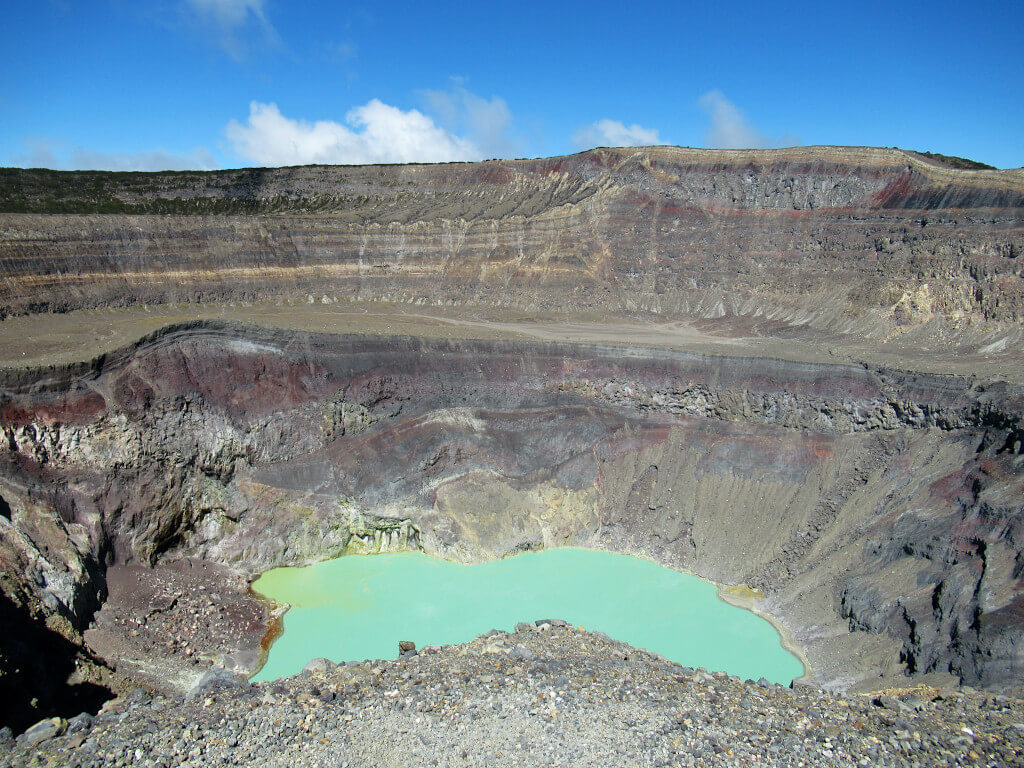
How to get to the Santa Ana Volcano hike start point
From Santa Ana City
The start point of the volcano hike is in a remote location. There’s only one bus each day from Santa Ana that will get you to the trailhead in time.
Take the number 248 bus from Santa Ana to the volcano. This bus leaves from La Vencedora bus station on the corner of 11th and 16th streets. You can find it on Google Maps by searching for ‘Sala de Espera y Abordaje “LA VENCEDORA”‘ (or clicking the link).
You have to catch the 7.30 am bus from La Vencedora. But don’t be surprised if it leaves 10 minutes late. Buy your ticket from the bus station for $0.90.
As you board, tell the bus driver that you want to go to Volcán de Santa Ana. This way, they’ll let you know when to get off. Normally, by shouting ‘volcano’ down the bus.
The drive takes around 2 hours and has some pretty impressive views. Especially, once you start gaining elevation around Lake Coatepeque.
If you miss the 7.30 am bus your only options are to take an expensive Uber – assuming someone is willing to drive the distance. Or, reschedule your trip for another day.
Unfortunately, the next bus isn’t for about 4 hours. This means you miss the hiking time and won’t be allowed on the trail.
From Coatepeque Lake
Most backpackers staying on the lake stay at Captain Morgan Hostel. This is one of the closest points of the lake to the volcano. But, the roads mean you have to go all the way around the lake to reach the trailhead.
You’ll first need to get to El Congo. This is where the buses from Santa Ana turn off the highway. You should be able to flag down the passing 248 bus anywhere from the El Congo Panamerican Highway turn-off, along Avenida Teniente Ricando Mancía and towards the RN10.
Expect the bus to arrive around 25 minutes after it leaves Santa Ana, so 7.55 am. However, in reality, it’s likely to be a little later than this. But, you don’t want to miss the bus as it’s the only one that will get to the trailhead in time to do the walk today. Be there at 7.55 am!
From the Bus Stop to the Trailhead
The bus will drop you off close to the Volcán de Santa Ana trailhead.
It’s likely that as soon you’ve stepped off the bus, you’ll be greeted by an official-looking representative of the volcano. The lanyard and/or polo shirt is deceiving though…
Typically, they tell you that there’s another group already waiting up the road and you can join them. Or that you have to take them as your tour guide. This isn’t true.
Instead, you can find volunteer tour guides at the park entrance. Here, they also charge a much cheaper rate than the person on the roadside is quoting. We were quoted $6 per person on the roadside, yet paid only $3 at the park entrance.
So, once you’ve got off the bus, head to the Santa Ana Volcano Trailhead. It starts in a dusty opening on the side of the road where two signs are pointing to Volcan Ilamatepec and Cerro Verde (pictured below).
Ignore the signs and head along the path out the back of this dusty area. After walking along the path between the trees, you’ll find an opening on the left-hand side that starts to head up the volcano.
The exact location on Google Maps is linked here – download offline maps to find it easily. Follow this until you reach the park entrance with small wooden huts and a place to pay.
It’s unlikely you’ll be the only tourist arriving on the bus. As such, I’d recommend grouping up and finding the trailhead together.
Travellers that save other travellers from being overcharged are worth their weight in gold. Plus, if you don’t speak English, teaming up means you’re more likely to find someone who does to navigate those trickier conversations.

Parking at Volcán de Santa Ana
A small amount of parking is available in the dusty area by the trailhead (pictured above).
Alternatively, head to the Cerro Verde Car Park. It’s 1.5 km further along the road away from the trailhead.
I’m not sure about the exact costs, but based on recent reviews the parking fee is between $1.50 to $3.
Hiking Santa Ana Volcano El Salvador: All you need to know
Entrance Fees & Costs
If you’ve avoided the guides on the roadside, you’ll need to pay for a guide at the park entrance. It’s not possible to hike Santa Ana Volcano without a guide.
Additionally, a couple of police officers may follow behind for extra safety. The police officers are more there for the reassurance of tourists than to negate any real threat of danger. And, in my experience, walk very slowly barely in sight of the group.
Although the guides are volunteers and the fee is meant to be a tip. My experience was that this was a mandatory tip. And, I had to pay it upfront and there was no negotiating. For 2023, this is $3 per person in cash.
You’ll also need to pay the park entrance fee here, which is $6 per person for foreigners ($3 for Salvadorian nationals). This also needs to be paid in cash at the ticket office. At the park entrance, you’ll also find the only toilets on the volcano as well as a couple of stalls selling drinks and snacks.
Total cost: $9 per person to hike Santa Ana Volcano and $1.80 return for the bus = $10.80.
I’ve seen other guides mention a national park entry fee of $3 (in addition to the park entrance and hiking fee) and a $1 access fee over private land.
I didn’t experience either of these. And, I also didn’t get asked for a national park entry fee at the official ticket office of the volcano where I paid for the hike entrance. Recent reports from late 2022 and early 2023 also confirm that these fees are no longer in place.
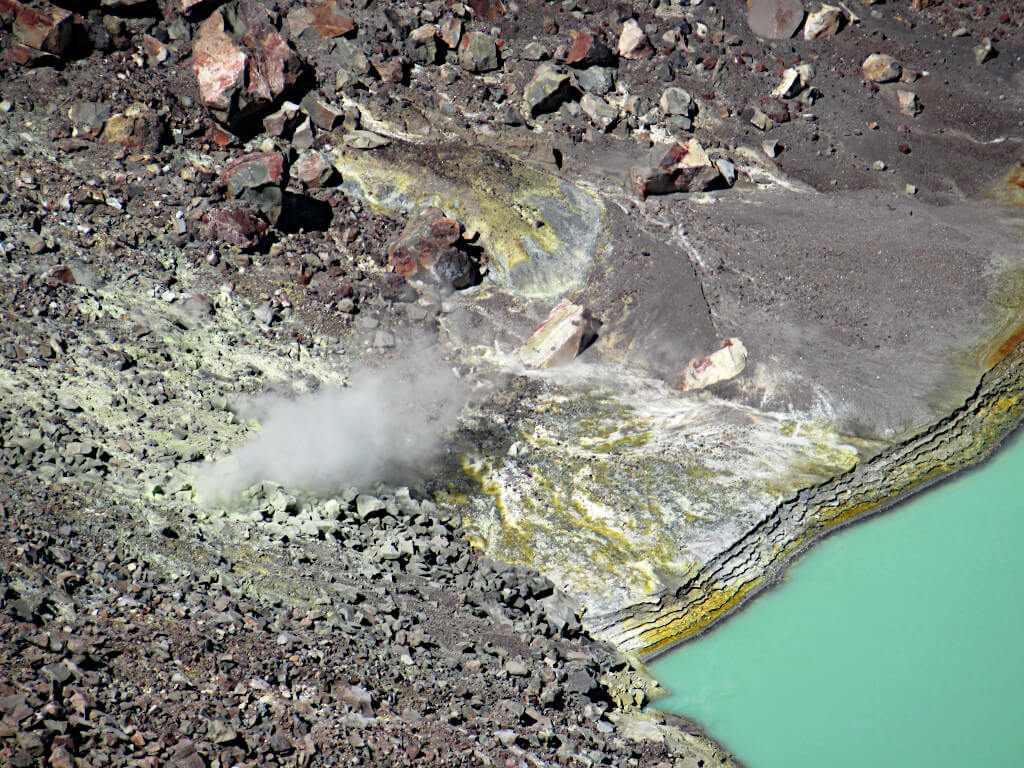
How long does it take to hike Santa Ana Volcano?
The Santa Ana Volcano hike time is around 1.5 to 2 hours to get to the top.
This includes the breaks you’ll definitely need along the way. To walk down leisurely, it will take another 75 to 90 minutes.
Although, if you’re aiming for the 1 pm bus and choose to run down (like I did), it can be done in as little as 45 to 60 minutes. More on that later!
Total walking time: 2 hours 45 mins to 3.5 hours. But don’t forget to add around 30 minutes at the top. Quicker if you jog down.
Hike Start Times
Some websites suggest that the Santa Ana Volcano hike doesn’t start until 11 am. However, this is no longer the case. For 2023, hikers must enter the trail between 7.30 and 10.30 am.
As you have to hike with a guide, you may have to wait a little while for a group to form. Particularly, if you arrive early in the morning.
Having set off at 9.50 am, our group arrived at the summit at around 11.30 am. This gave us plenty of time to enjoy the view and take photos before setting back off.
At midday and after around 30 minutes at the top, I set back off jogging down the volcano to make the 1 pm bus. Which, inevitably, didn’t arrive until about 1.25 pm. But, exercise is good for you, right?!
Although you are required to go with a tour guide, our group was quite large and spread out. And, when it came to descending, they really did not seem to care if you went down without them (which I did).
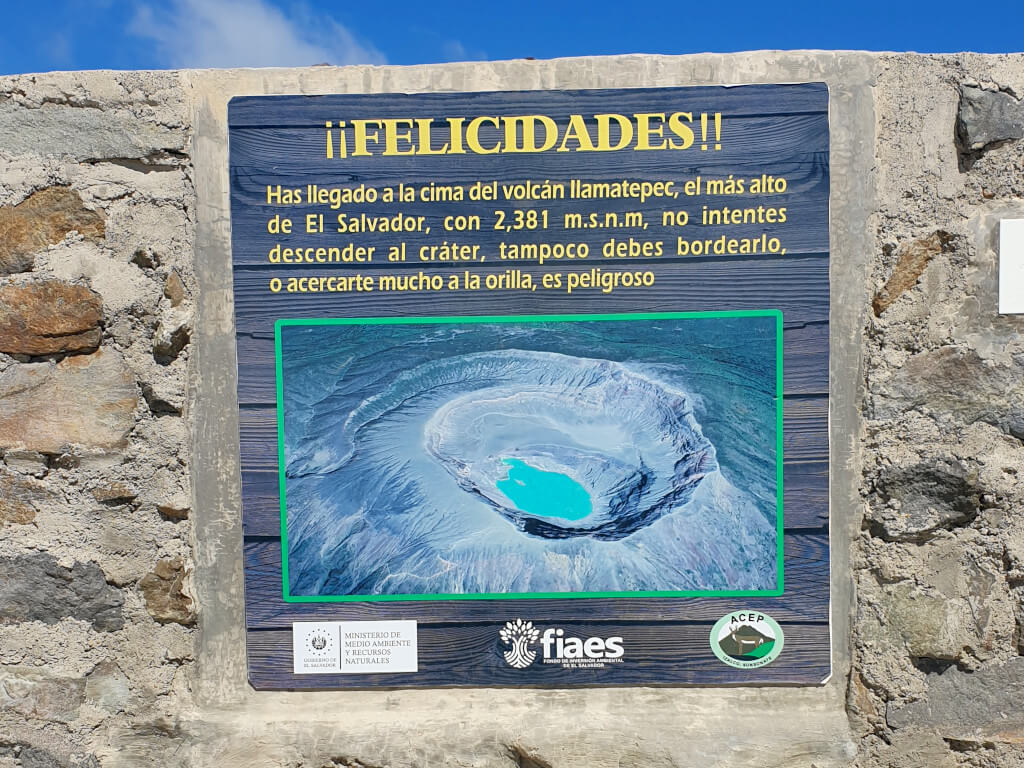
How difficult is hiking Santa Ana Volcano?
The Santa Ana Volcano hike isn’t so difficult, it’s just hard work. The hike is 3.5 km up and 3.5 km back down, with over 450 metres of elevation gain.
The climb is not technical or particularly challenging. Rather, the hot and/or humid conditions make you sweaty and dehydrated easily.
Luckily, there are a handful of viewpoints along the way where you can rest and admire the view. Unfortunately, once you get above the trees, there’s almost no shade. There was a man selling ice lollies at the top though.
I am by no means fit, but I huffed and puffed my bright red face all the way to the top in less than 2 hours. If I can do it, you can too!
Weather & Conditions on the Volcano
There are only two real seasons in El Salvador. A rainy season, which runs from May to October, and a dry season, running from November to April.
The rainy season brings afternoon downpours, more clouds and humid conditions. While the dry season tends to bring sunny weather all day long. But, of course, there’s never any guarantee when it comes to weather at this altitude.
Doing the Santa Ana Volcano hike in the dry season gives you the best chance for clear conditions. But, you might not always get to choose when you go if you’re already in El Salvador.
Unfortunately, it can be hit-and-miss when it comes to visibility at the crater. I know people who climbed to the top only to be able to see thick clouds, they didn’t even get a glimpse at the crater lake.
Sadly, it’s impossible to predict conditions at the volcano summit based on the weather in Santa Ana. But, the conditions change quickly and a gap in the clouds is always a possibility.
What to Pack for the Santa Ana Volcano Hike
You don’t want to carry too much, but you also don’t want to go without. I’d suggest the following:
- 1.5 to 2 litres of water or squash
- A couple of snacks that don’t melt. Particularly as even after the hike, it’s another 2 hours on the bus back to Santa Ana
- Sun cream and sunglasses
- Camera, phone and battery pack
- Enough cash to pay for the return bus fare, park entrance and guide fee
What to wear for hiking Santa Ana Volcano El Salvador:
- Trainers are fine – but you can wear walking shoes/boots if you have them
- Light-weight clothes such as sports tops or shorts. Remember, you also have to wear them for 4 hours on a chicken bus, so I don’t think trousers or long tops are as suitable
- A hat, if you have one
- Comfortable underwear and socks that don’t fall down as you walk. We’ve all been there pulling up pants all day or your sock rolling down into your shoe when you’re walking. Wear your most comfortable and practical items!

Return Travel after The Santa Ana Volcano Hike
After the bus has dropped you off at around 9.30 am, you have two choices for getting back to Santa Ana or El Congo. The next bus is at 1 pm and the one after that isn’t until 4 pm.
To make the 1 pm bus, you need to leave the peak of the volcano no later than midday. And, you’re going to need to jog a good portion of the 3.5-km route back. Alternatively, you can sacrifice some of your time at the top for a less strenuous climb down the volcano.
Once you make it all the back to the start of the trail, turn right from the trailhead onto the road. There’s a small bus shelter on the left side of the road.
The buses aren’t the most reliable and the 1 pm bus can easily be 30 minutes late. Unfortunately, there’s no way of knowing when it will or won’t be on time, so you need to be there at 1pm.
If you miss the 1 pm bus, you can have lunch and enjoy some cold drinks at the small number of roadside restaurants around. Then, keep an eye out for the 4 pm bus.
If you’re staying in Santa Ana, it’s also possible to spend the afternoon at Lake Coatepeque. You’ll need to take the 248 bus to El Congo and then take alternative transport to the lake (most likely a taxi).
When you’re ready to return to Santa Ana, head back to El Congo and flag one of the many passing buses travelling from San Salvador City to Santa Ana.
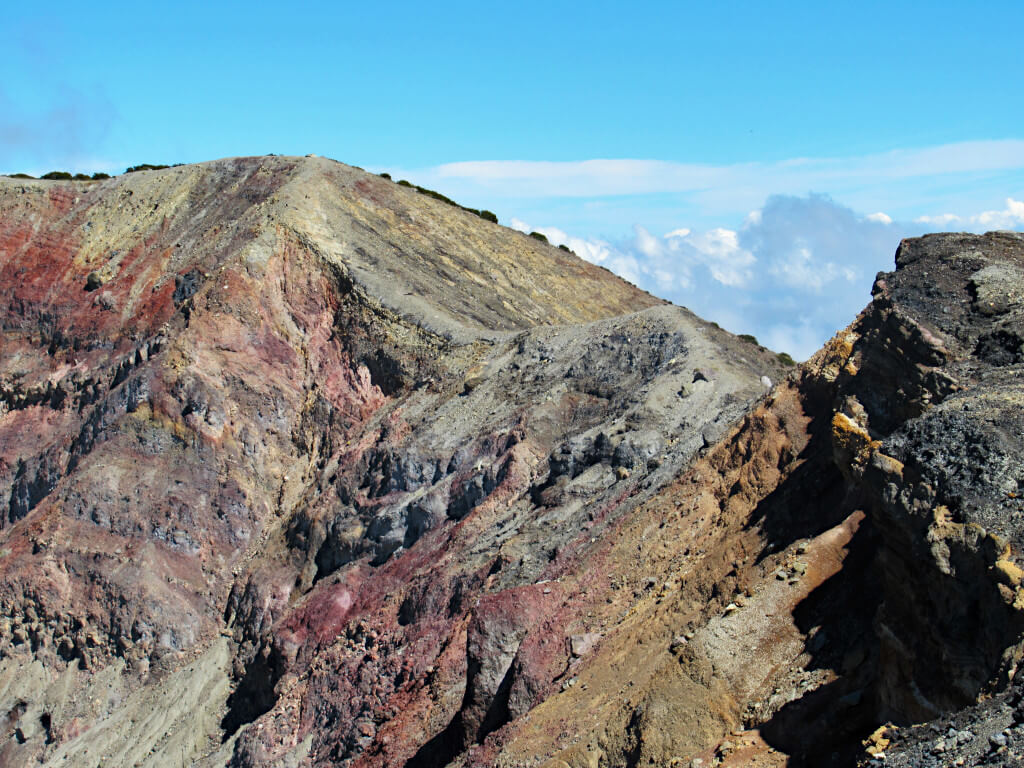
FAQs
Once you reach the volcano summit and look over the crater edge you’ll see a vivid green sulphur lake.
The crater itself is stunning to look at with rocks of all colours and incredible layers created by eruptions over the years. You’ll also see steam pouring out some of the gaps in the volcanic rock.
Unfortunately, you can’t go inside the crater as it drops almost vertically down to the flat ledge halfway down. And then drops equally as steeply to the lake in the middle. You also can’t walk all the way around the crater due to the loose rock and the risk of falling into (or down the outside) of the volcano.
No – and you wouldn’t want to either, the pH is about 1. Meaning it’s pretty much the most acidic a substance can be.
It would be like bathing in stomach acid. And, if that’s not enough, the sulphur in the lake produces a strong eggy smell that isn’t particularly pleasant. Depending on the conditions and wind direction, you can also smell it at the crater and/or on the ascent.
If you want to relax after the Santa Ana Volcano hike, head to the Salto de Malacatiupan hot springs. Here, you can bathe in naturally heated 36 Celsius/97 Fahrenheit volcanic spring water. Perfect for tired muscles after a long hike!
Yes, the volcano is still classed as active.
The last eruption was in 2005 but there have been signs of activity since then. For example, in 2007, seismic activity caused 85% of the sulphur lake to evaporate.
The volcano is monitored for signs of activity. And though no activity is without risk, hiking Santa Ana Volcano El Salvador is relatively safe in terms of avoiding a volcanic eruption.
Earthquakes are common in this part of the world as all of Central America sits on the Pacific Ring of Fire. Which is notorious for frequent seismic activity. However, most earthquakes are small and aren’t felt by people.
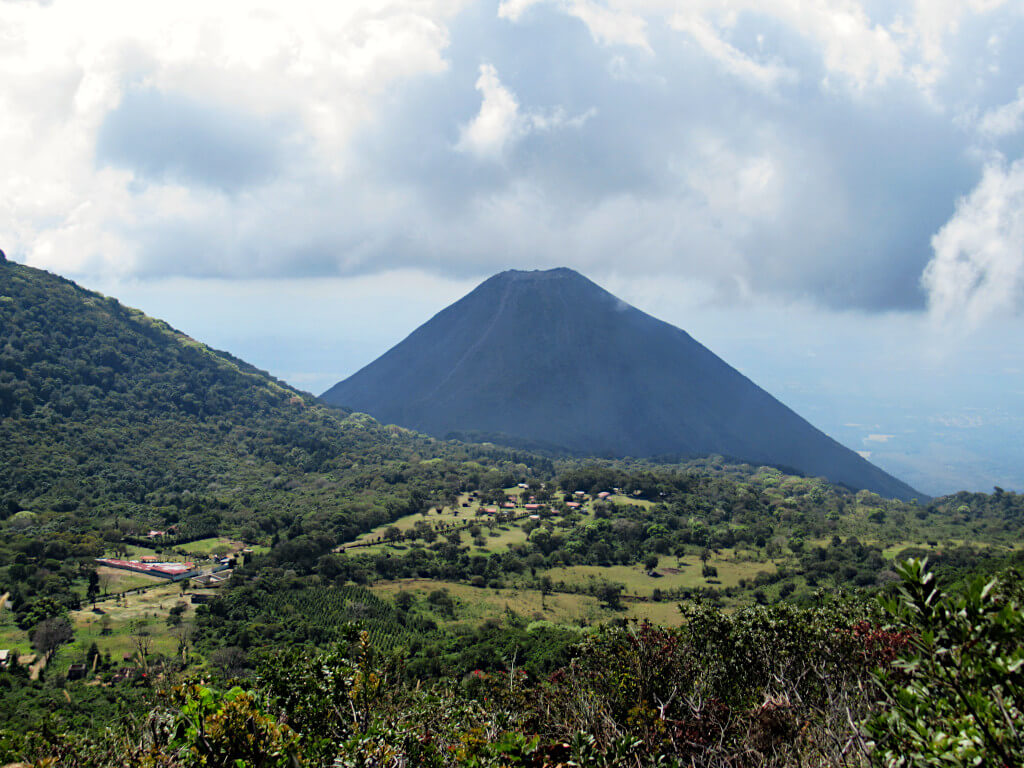
Where to Stay in Santa Ana
I’d recommend staying at least two nights in Santa Ana if you want to do this volcano trek. After a hard hike, the last thing you’ll want to do is get on another bus to a new destination.
For hostels, I’d recommend either Pool House Hostel. I stayed here for 7 nights in total and really loved it. The hostel is small, with one private room and two dorms. But has a pool and a fully equipped kitchen for you to use. Plus, the owners are lovely and have the cutest dog!
Another popular place is Hostel Casa Verde. Although I personally haven’t stayed here, it comes highly recommended by many people I met in El Salvador and beyond.
If you’re looking for a hotel, the Remfort Hotel has amazing reviews. The hotel’s just a few blocks from the centre of Santa Ana and the La Vencedora bus station.

If you have any questions or want any more information drop a comment below and I’ll get back to you!
Prices and offerings mentioned are correct as of January 2023 but are subject to change in future.
More Central America Travel Inspiration…
El SALVADOR: El Tunco El Salvador: Ultimate Visitor’s Guide
EL SALVADOR: Salto de Malacatiupan (Hot Spring Waterfalls & River in El Salvador)
GUATEMALA: Acatenango Hike: Complete Guide to this Volcano Trek
GUATEMALA: Indian Nose Hike (Watch Sunrise Over Lake Atitlán): Complete Guide
BELIZE: Caye Caulker Snorkeling: An Underwater Paradise (Need to Know)
NICARAGUA: San Ramón Waterfall, Ometepe: Complete Guide (100% Worth The Hike)
HONDURAS: Pulhapanzak Waterfalls: Complete Guide To Visiting
PIN IT FOR LATER!
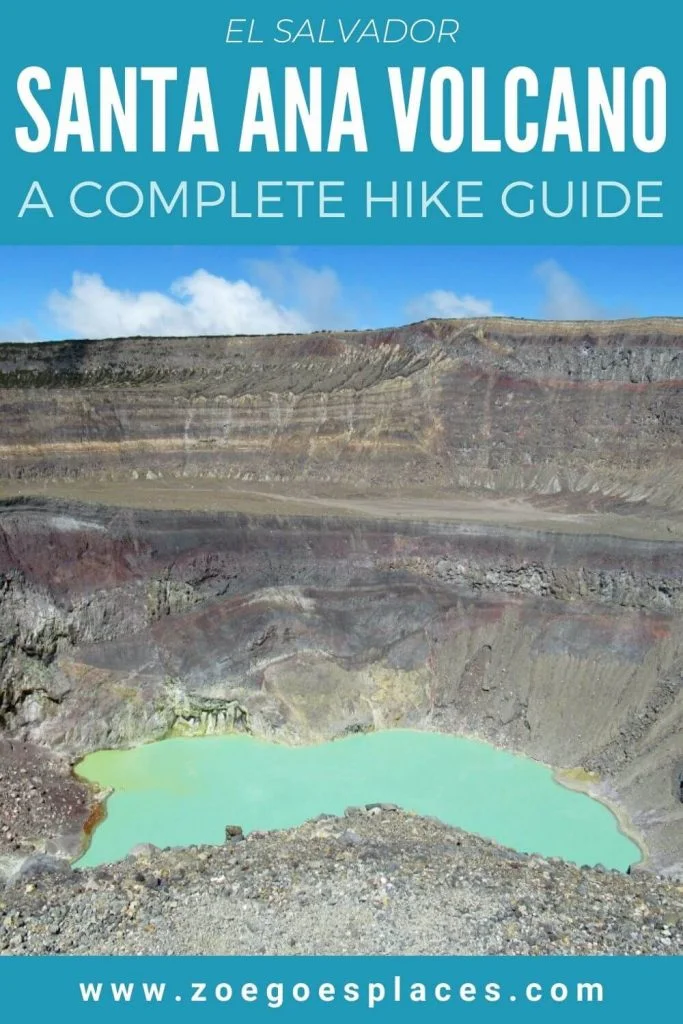
This is great. One question though. Trying to make the 1pm bus back could be done easier if one takes and uber to the start and ideally gets an earlier start time. Do you think that would work (I.e. did you see many groups ahead of you? Maybe already coming down when you were approaching the top)?
Thanks.
I think taking an Uber there would definitely make it easier to get back for the 1 pm bus. The only potential issue is that there is no guarantee a guide would start the hike with you straight away, as they may want to wait for more people to join. However, I do think most days it is normally busy enough that you’d get a head start.
When I went, there was only 1 group ahead of us. But I don’t think they could have been that far ahead, as most of them were still at the summit when I set off back down. I’ve seen recently that people have hired scooters in Santa Ana and rode to the trail head themselves – not sure if this is something you’d be comfortable doing, but is an option.
Amazing well explained and super detailed article. Reading blog posts like yours is extremely helpful. Thank you for sharing all this information.
So kind, thank you!
Your guide on hiking Santa Ana Volcano is absolutely fantastic! I can’t wait to experience the views and adventure – the crater looks epic!